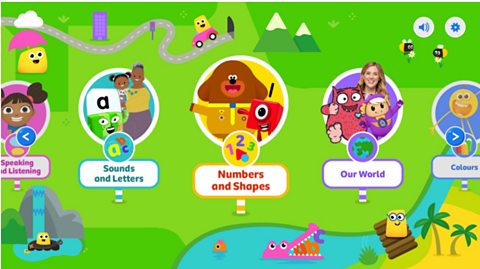It's school offer season across the UK, a time when parents find out which school their child has been offered a place at. For parents of children preparing to start primary school, knowing how to prepare their child for school might seem a bit daunting, but Bitesize and CBeebies are here to help.
The CBeebies Little Learners app is full of fun, educational games and videos that are mapped to the Early Years Foundation Stage - to help your child get ready for school. And brand new to the Bitesize area of the Cbeebies Little Learners app this week are some films from the upcoming new series of Cbeebies' Time For School. These feature some great activities led by pupils from reception classes - showing you and your child what life is like at school, and offering some fun ideas that you can do with your child at home to help prepare them for starting school.
Hereãs a peek at the films - as well as some insight from Early Years Educational consultant Heather Sargeant on why these activities are great for little ones and how parents and teachers can help children learn by doing them.
Primary school places 2024: When do parents find out offers?
1. How does exploring outdoors help my child to learn?
Child: When itãs time for school we love to learn about outdoors.
Child: We're all going on a mini beast hunt, why don't you join us?
Adult: So remember when we are hunting for our minibeasts you must use kind hands and when we finish looking at our minibeasts we'll put them back where we found them.
Child: We have a list of different bugs, when we find one we tick it off.
Child: No bugs!
Child: Oh, there! I found a slug!
Adult: Sadie, should we go and look under these logs here?
Child: Yeah I wonder whatãs under them.
Adult: I wonder whatãs under them.
Adult: What can we see?
Child: Some woodlice.
Adult: So how many can you see Sadie?
Child: Seven.
Adult: Seven?! Gosh thatãs a lot living under the log, isnãt it? I wonder Sadie, what are those bits on the top of his head?
Child: The eyes.
Adult: Do you think theyãre his eyes? Oh heãs looking at you now! So Sadie, do you think we should put him back now weãve finished looking at him?
Child: Yeah, back on his log.
Child: If you want to go on your own minibeast hunt, remember these thingsãÎ
Child: Have a list of minibeasts to tick off when you find them.
Child: Always put your bugs back where you found them.
Child: And always wash your hands afterwards.
Child: Remember to have kind hands when you're holding bugs.
Child: Thanks for joining us, it's been really fun!
All: Bye!
There are so many reasons to be outdoors ã it helps us to be active and is good for us physically. Alongside these benefits, taking notice of the things around us outdoors also helps a child to learn. It provides both teachers and parents with lots of opportunities to talk about nature, such as the colours or parts of plants and flowers. We can also talk about the weather, for example the bright sunshine or drizzle, and the clothes we've chosen to wear to be outdoors.
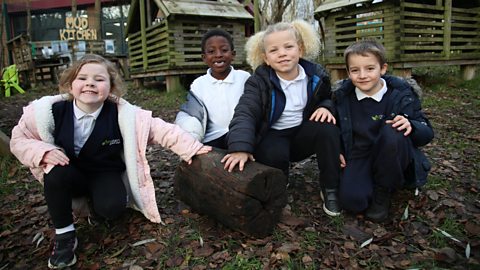
This begins to lay the foundations for new vocabulary and develops conversation through asking and answering questions. We can also draw a childãs attention to different things that we notice by discussion, pointing and counting small groups of things together, which is brilliant for learning as children need to follow their teacherãs guidance with longer stretches of attention and more focus when they start school.
A scavenger hunt is a great way to embrace active learning with your child. You can do this together by drawing things to look for as a list when you go outside. This could be things you know you will spot on the way to places such as their nursery, or different things to find in a local park (like leaves, trees, flowers, stones and paths). Scavenger hunts also develop a learning ãqualityã, which is our ability to ãtry againã when we donãt find something immediately. You can show your child this quality by helping them if something is more difficult to spot.

2. How does counting and playing games help my child learn numbers?
Child: When itãs time for school we love to learn about numbers.
Child: Hi I'm Rudy and a fun way to learn about numbers at school is finding things and counting them. Why don't you play along?
Child: Iãve hidden these pebbles around this area, how many can you find?
Child: Found one!
Child: Found it!
Child: Found one!
Child: Found one!
Child: Letãs hear how many you found. Emily, you go first.
Child: One, two, three, four, five, six, seven.
Child: Letãs see how many Sadie has.
Child: One, two, three, four, five, six, seven, eight, nine, ten.
Child: Who do you think has the most? Itãs Sadie, as ten is more than seven. Why donãt you count to ten with us?
All: One, two, three, four, five, six, seven, eight, nine, ten.
Child: Thanks for joining us, itãs been really fun.
All: Bye!
Children experience and learn the sequence of numbers from hearing others using them. Often there are number rhymes and songs which develops a knowledge of the sequences.
It's a different thing to learn and understand how many objects are in a small group. Being able to look at a group and say the quantity is called ãàì°ÉýºƒÝ°ìƒÝý¾ƒÝýåýçã. To be able to do this we need lots of experience of counting groups, so we know how to relate each separate object to each number when counting.
In this film, we see the children being active and collecting a set of objects and then counting how many they have. You could do this too by counting and pointing to show your child how to count a small group of objects ã drawing attention to each separate object by pointing, or physically putting the objects down on the ground as you count.
Some ways to do this outside are counting towers of stones (if they are fairly flat pebbles), counting a small collection of leaves in autumn, or counting the flowers on a plant (as long as it is a fairly small group of flowers). As a general rule for pre-schoolers, stick with numbers less than five first and then groups of up to ten.
3. How can exploring colours help my child to learn?
Child: When itãs time for school we love to learn about colours.
Child: Hi, Iãm Jude and a fun way to learn about colours, is by playing a colour mixing game. What colour is this? It's red. And what colour is this? Itãs yellow. And when you mix them together what colour does it make?
Child: Theyãre Orange!
Child: Letãs try some other colours.
Adult: Looks like a dark green, isnãt it?
Child: Yeah
Adult: What does that feel like, Jasper?
Child: It feels just gloopy.
Adult: Jessica, what does it feel like?
Child: It feels wet cold and it feels like snow.
Child: Ah, Jess! You splashed some at me.
Child: Sorry.
Child: Red and white make pink.
Child: Ah, Jess. Donãt touch me!
(Giggles)
Child: So we found out that red and yellow make orange.
Child: And red and white make pink.
Child: Thanks for joining us, itãs been really fun.
All: Bye!
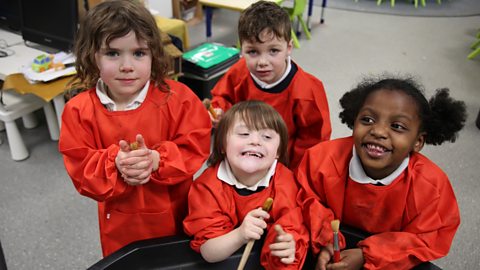
Exploring colours and paint mixing (using child-friendly paint) is a great activity to try with your child, and by using fingerprints or handprints, it becomes a lovely sensory activity. There are lots of opportunities to talk about food or objects that are a particular colour (which will help your child to make links) and to talk about the look, feel and texture of the paint. Rubbing the paint together with fingers is also a way of actively learning about mixing and achieving the goal of creating other colours and shades.
The more that children experience different colours, the more likely they are to incorporate this vocabulary in their speech. This will help them to talk about new and unfamiliar things by describing them, for example, describing the colours of nature or objects.

4. How can talking about feelings help my child?
Child: When itãs time for school we love to learn about feelings.
Child: Hi, I'm Tilda, and we like to learn all about our feelings at school. We're using pebbles. I'll show you how. Iãm feeling happy today so I will put it in here.
Child: Iãm okay, so mine goes in here.
Child: Iãm a little worried.
Teacher: Good morning everybody. Who would like to tell me where they put their pebble? Rudy, would you like to share now or later?
Child: Now. Iãm worried that I wonãt have anyone to play with.
Teacher: And what do you think we could do to make Rudy feel better? Timothy.
Child: Why don't we ask Rudy if he would like to play with us?
Teacher: Great idea. What do you think, Rudy?
Child: Would you like to play with us?
Child: Yes.
Child: Tig, youãre it.
Child: Iãm feeling okay now.
Child: And remember, however you are feeling that is okay. And you are always talk to a grown up.
All: Bye!
We can all benefit from recognising that our thoughts, feelings and behaviours are different parts of a cycle. Our thoughts influence our feelings, leading to actions that then affect our thoughts - starting the whole cycle again. By giving our children the words and sentences about this, we can help them to express themselves and find ways to problem solve. This isnãt something that our children will have developed by the time they start school, and the parts of our brain that help us to manage this cycle donãt fully develop until our mid-twenties, so we need patience when our children have big feelings.
At home, we could describe our own feelings and how we manage them in a simpler way for our children. Our children will pick up on our feelings - and by using simple vocabulary, we can explain how we negotiate our own thoughts, feelings and behaviours.
For example, instead of saying "a cup of tea solves everything", we could say "I'm feeling a bit sad as I have been thinking a lot about hard/sad things today. I know having a cup of tea helps me to stop for a moment, so I am choosing to do this." It might sound like a lot of words (and we probably wouldnãt do this every time!) but it helps our child to understand that our thoughts and feelings are separate to theirs, and that we can talk about feelings. The vocabulary of ãhappyã, ãsadã, ãangryã and ãworriedã is a good place to start, as is recognising that our feelings are changeable and that feelings often pass.
Like we see in the clip, having a picture card or a pebble can help children who havenãt mastered the language to express themselves and share their feelings. This is especially helpful in the early years and throughout primary school. Youãll find that many schools and classrooms have a way of ãchecking inã with feelings as a part of the school day.
These seven Hey Duggee videos have been created to help children aged 3-5 explore and identify different feelings (angry, happy, scared, sad, tired, excited and upset).
5. How can I help my child to notice letters and sounds every day?
Child: When itãs time for school we love to learn about letters and sounds.
Child: Hi, I'm Timothy. And at school we like to learn about letters and sounds. Why don't you join in? Iãm gonna hold up a letter and you are gonna find something in the playground beginning with that letter. And our first sound is ss.
Child: Yes, slide begins with a ss.
Child: The sand begins with a ss. Yes it does.
Child: Well done. And our next sound is tuh.
Child: Tuh, tuh, tuh. What begins with tuh?
Child: Itãs a tuh-table.
Child: Thereãs a tree, it begins with a tuh.
Child: Yes, letãs try another sound. Itãs a ah.
Child: Itãs a apple.
Child: Look, it;s a arrow. Ah-ah for arrow.
Child: We've been spotting things with this sound. Can you remember what we found? Itãs ss for sand and slide. How about this sound, it's tuh for tree and table. And this sound, itãs ah for apple and arrow. Thanks for joining us. It;s been very fun learning our letters and sounds.
All: Bye!
As your child starts at primary school, the school will let you know about the phonics programme they follow. Phonics is the process in school of teaching children the correlation between letter sounds and how those letters look when written. Schools can choose from a list of approved phonics schemes and then stick to one approach. As a parent, it's useful to know a couple of things.
Firstly, stick with the sounds that letters make when you're talking about objects or names. Developing strong links between the letter shape (grapheme) and the letter sound (phoneme) is one of the building blocks of literacy - and strengthening these links is helpful.
Secondly, play sound games e.g. "I spy with my little eye, something beginning with the soundãÎ" or "How many things can we spot on our journey beginning with the sound ãt'?". If you join in with these games, you can model the letter sound links, drawing your childãs attention to something and separating the initial sound (which is called segmenting or isolating).
Thirdly, give a good model of sounds. Many children wonãt develop all their speech sounds by the time they start school, so it really helps for you to positively repeat words with the sound articulated correctly e.g., "thatãs right ãjã is for jelly."
If you are concerned about your childãs speech sounds, you can speak to your childãs nursery/preschool, GP or Health Visitor.
6. Why is listening and attention so important for my child's learning?
Child: When itãs time for school we love to learn about good listening.
Child: Hi, I'm Lois and the fun way to learn about good listening at school is to go on a sound walk. Why don't you come with us?
(Phone ringing)
Child: Stop! Did you hear that? What do you think it is?
(Phone ringing)
Child: Itãs the sound of a phone ringing.
Adult: Good morning, how may I help?
All: Hi Miss Angela!
Child: Letãs listen out for some more sounds.
(Water rushes)
Child: What's that sound?
Child: It's the sound of a tap.
Child: Let's listen out for some other sounds.
(Tambourine rattles)
Child: What's that sound?
(Tambourine rattles)
Child: It's the sound of a tambourine!
Child: On our sound walk we heard the sound of our school phone ringing.
(Phone ringing)
Child: A tap running.
(Water rushes)
Child: And some children playing the tambourine.
(Tambourine rattles)
Child: Listening in school is really important.
Child: When our teacher tells us what to do.
Child: And so we can listen to stories.
All: Listening helps us learn. Bye!
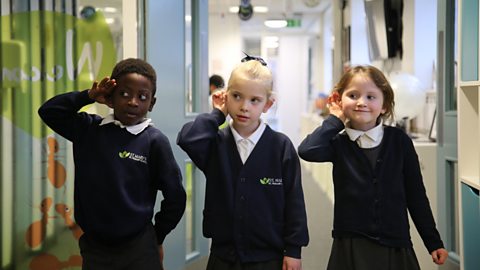
Children usually develop their attention throughout the early years. We might be more aware of the steps for learning to read or learning to write, but a lot of these things are more difficult to learn if a child hasnãt developed attention and listening skills.
The earliest stage is called ãfleeting attentionã, which is when a childãs attention flits from one thing to another quickly. When a child is able to give attention and shift their attention when they need to, we call it ãintegrated attentionã. This is what each of us needs to be able to do to learn well.
There are many small things that we can do to develop attention. Mostly, we can play with or alongside our child. That means following their lead, joining in with their interests and games and encouraging them to stay focused on the game or toy by developing and extending the play. Sharing a picture book with your child is also a good way to develop attention as you can read a page to them and ask whether they can see a character or something else in the illustration.
The key thing to remember is that attention first starts to develop when you're following an interest, so take notice of the things your child pays attention to and follow these interests.


is a learning app from CBeebies and ôÕÑ¿å¥éá Bitesize, that puts the fun into learning!
Aimed at 2-4 year-olds, the app is free to download with no adverts or in-app purchases and children can play independently and offline, wherever they are. It's packed with free CBeebies and ôÕÑ¿å¥éá Bitesize games and videos featuring CBeebies characters, and all the activities are based on the Early Years Foundation Stage (EYFS) curriculum.

More from ôÕÑ¿å¥éá Bitesize Parents' ToolkitãÎ
Parents' Toolkit
Fun activities, real-life stories, wellbeing support and loads of helpful advice - we're here for you and your child.
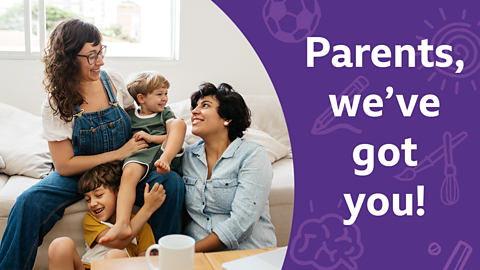
Starting Primary School
Advice and games to help you and your child prepare for primary school, then thrive during their first year.
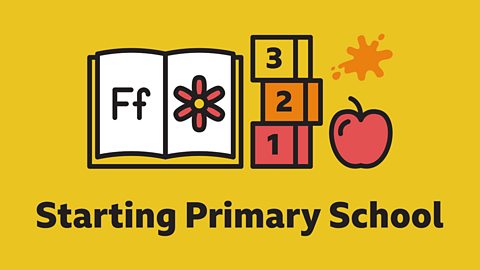
Seven ways to support your child with SEND at school
Dr Anne Emerson, Associate Professor in Special and Inclusive Education, provides tips on how to help support your child during their time at school.
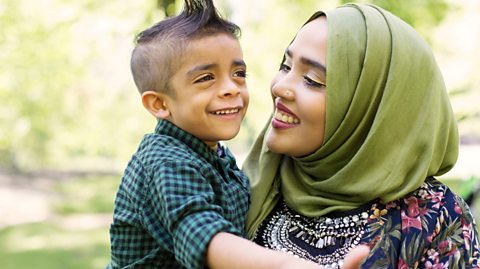
Outdoor games for explorers
Five adaptable games to help get your child outdoors and loving their environment
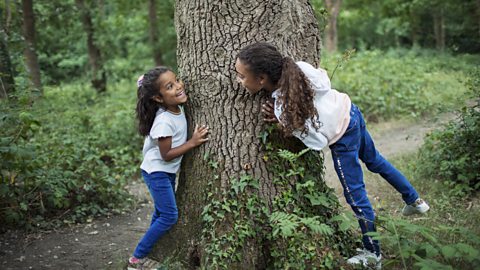
Top tips to support your child's reading at home
Language development expert, Tara Parker, suggests some top tips to help you make the most of your child's reading time. From ôÕÑ¿å¥éá Bitesize.
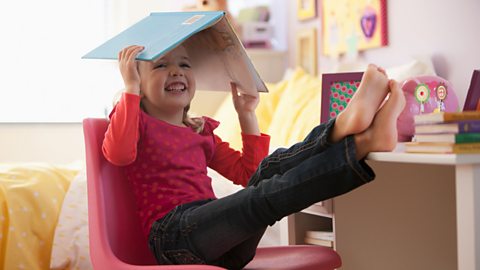
How the CBeebies Little Learners app makes screen time a good time for your child
The CBeebies Little Learners app is a great way for younger children to access safe, curated content from the ôÕÑ¿å¥éá with no adverts and no in-app purchases.
